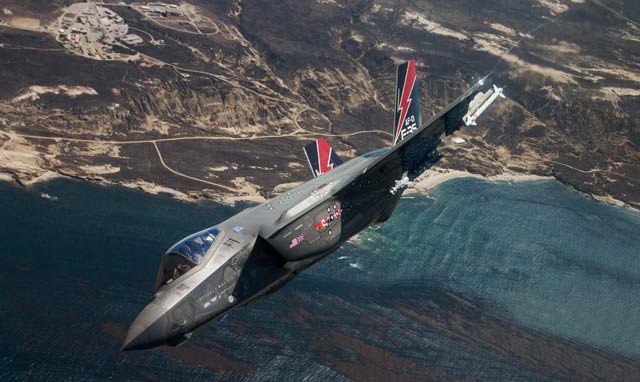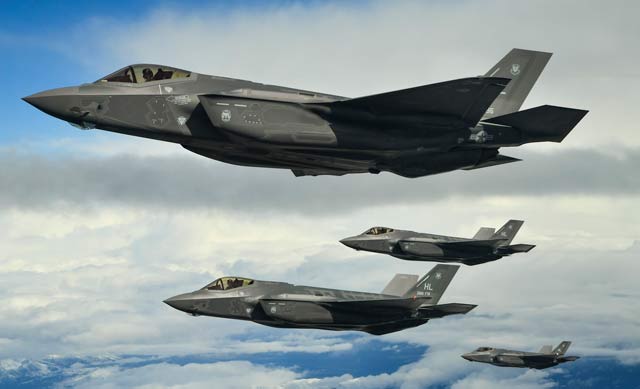Lockheed Martin’s F-35A will soar above the Paris air show this June, marking the first time a US-made stealth aircraft has visited the event since 1995.
Two F-35As will depart from Hill Air Force Base, Utah, and Luke Air Force Base, Arizona, with US Air Force pilots, though Lockheed pilots will perform the demonstration at the show. The USAF cited a limited number of aircraft, pilots and maintainers but plans to develop its own F-35 demonstrations beginning in 2018, according to a service statement. The two F-35s will perform more than just a flyover, according to a Lockheed spokesman who declined to elaborate on whether the aircraft would land at the show.
“We are not giving out any details of the show, we want to keep the suspense,” he says. “If you come to the show, you’ll get to see what the aircraft will do.”
Although the short-takeoff-vertical-landing F-35B variant appeared at the Farnborough air show last year, the conventional takeoff and landing variant has not made a transatlantic trip outside of its recent deployment this spring for the European Reassurance Initiative effort. But the visit should be a treat for European audiences, who have not seen a US stealth aircraft over Le Bourget since the Northrop Grumman B-2 bomber flew past the show in 1995.

Lockheed hopes an F-35A appearance at Le Bourget will boost sales prospects in Belgium, Finland and Switzerland
Lockheed Martin
Controversy over possible French industrial espionage broke out after the last static display in 1991, when the F-117 visited. Before those accusations, the US Defense Department funded displays of its aircraft. But information from US intelligence agencies prompted the end of DoD – and by extension US aerospace industry – involvement in the Paris air show.
Get all the coverage from Paris air show check out our dedicated event page
Lockheed’s F-22 was scheduled to visit in 2009, but the USAF cancelled the appearance, citing availability of the aircraft. When asked whether Lockheed has concerns over bringing stealth aircraft to Paris this year, a Lockheed spokesman was terse: “We have full confidence in the [US] air force ensuring their jets are secure.”
Although France is not purchasing any F-35 variant, the French already have some hands-on experience with the Joint Strike Fighter after completing a recent trilateral exercise with the USAF and Royal Air Force. French Rafales performed the exercise with British Typhoons, USAF F-35As and F-22s at Langley Air Force Base, Virginia this April. The event focused on preparing the allies for a high-end air-to-air fight with a peer adversary, such as Russia.
“We build with the RAF and US Air Force a high level of confidence between the crews and aircraft,” Rafale pilot Lt Col Yann Malard told FlightGlobal during the exercise. “This is important to share our different tactics if we have to fight in high intensity conflicts together, and that may happen soon. It is very important that we know each other.”
The three partners can share information, but sharing classified data remains an issue on the F-35. But that doesn’t change the way the Joint Strike Fighter operates with UK and French fighters today, Malard adds.
During the trilateral event, the F-35 shared less information with its partners than it would during a contingency operation, says Col Joseph Kendall, chief of the tactical data links enterprise division at USAF Air Combat Command.
“We would probably allow a little more information to flow in those environments,” Kendall says of an operational mission. “It’s something that we’re cognisant of and something we’re working on to the maximum extent possible. We obviously need to protect our methods and sources while still maximizing the amount of information we can distribute and we’re finding responsible and thorough ways to achieve that.”
Kendall also acknowledges the F-35 programme could update its Link 16 communication system. The F-35, Rafale and Typhoon are all able to share information because they are both MADL and Link 16 capable, but the F-22’s Link 16 network can only receive data from the F-35. A plan exists to bring a Link 16 transmitter to the F-22; Kendall would only elaborate to say he would like to see the capability arrive within the next seven years. The air force is considering incremental improvements to Link 16, but developing a new waveform is also under discussion, Kendall says. The service has examined the Navy’s Tactical Targeting Networking Technology (TTNT), though not as extensively as the Navy is at this time, he adds.
Neither the USAF nor Boeing have firm plans to create a gateway similar to the Talon HATE pod, which allows the Boeing F-15C and Lockheed F-22 to communicate with each other.
“As we look at Link 16 and we look at how many countries have signed onto the coalition to be a part of the Link 16 enterprise, we have to ask the question: should we make small improvements to Link 16 to keep it moving along?” Kendall says. “And not have to do a full-scale divestiture into some new waveform, now we’ve got to get this joint coalition partnership... it appears Link 16 is the way forward for the majority of scenarios that we will run into across the range of military operations.”
Lockheed is projecting confidence with its F-35A visit to Paris, but the programme has some work to do before it catches up to its objectives. Lockheed is behind pace in its F-35 delivery, with the Pentagon’s Defense Contract Management Agency estimating the company will deliver nine fewer than the projected 66 aircraft for this year. During a December 2016 tour of the F-35 production facility in Fort Worth, Texas, Lockheed officials told FlightGlobal the plant would make 67 jets in 2017 and reach a 100 rate in 2018. Production should peak in 2023 with 178 jets that year, F-35 production vice-president Janet Nash said.
A recent Government Accountability Report threw more cold water onto Lockheed’s progress. Mounting testing delays could cost the Pentagon more than $1 billion to complete development of the baseline programme, the April report states. Rather than wrapping up developmental testing this October, the GAO estimates that issues with the Block 3F mission system software could push the end of testing to May 2018.
“These delays could affect the start of the F-35’s initial operational test and evaluation, postpone the Navy’s initial operational capability and delay the programme’s full rate production decision, currently planned for April 2019,” the report states.
If the year-long delay persists, the F-35 programme will require an estimated $1.3 billion in fiscal year 2018. Another $1.2 billion will fund Block 4 modernisation effort and bulk quantities of the aircraft. The GAO report warns against both funding Block 4 before 3F testing has completed and ordering additional aircraft before finalising the Pentagon’s 2018 budget.

One Paris-bound F-35A will be drawn from a detachment based at Hill AFB in Utah
US Air Force
The delay was first revealed in December by then-F-35 programme executive officer Lt Gen Chris Bogdan. The Pentagon directed the Joint Programme Office to complete the system development and demonstration phase as quickly as possible, but Bogdan added that the date would be event-driven. Bogdan noted his office would take money out of follow-on modernisation to finish SDD: “We will continue SDD until all the 3F capabilities are matured, tested, verified and delivered as we promised. The JPO has been directed to prepare to add resources to flight testing beyond October of 2017 to May of 2018, if it is necessary to do so.”
The F-35 programme continues to struggle with its Block 3F software, which will give the aircraft full combat capability with upgrades such as a larger synthetic aperture radar map. The USAF F-35A reached initial operational capability with the 3i configuration last August. However, programme officials spent part of 2016 addressing issues with the 3i mission systems unexpectedly shutting down and restarting, which delayed Block 3F testing according to the GAO report. The programme office diverted resources from Block 3F development to address 3i issues, which compounded delays after instability issues occurred on Block 3F.
For Lockheed, a solid performance at Paris could help overshadow programmatic woes and serve as a high-profile advertisement in front of European consumers. Finland, Belgium and Switzerland’s pending fighter deals will hang in the air at Le Bourget and Lockheed’s demonstration will no doubt mark an important dance in the courting ceremony.
In May, Finland was in the midst of analysing responses to requests for information for its HX programme, which will replace the air force’s fleet of aging Boeing F/A-18C/D Hornets with 64 multi-role fighters. The competition won’t heat up until 2018, but Boeing’s F/A-18E/F, Eurofighter Typhoon (represented by BAE), Dassault Rafale and Saab Gripen E are expected to be top contenders with the F-35. Finland’s defence ministry has not put a premium on low-observability, a key F-35 selling point.
Finland’s stance on stealth could give a leg up to Boeing, which is selling its newest Super Hornet configuration not on stealth capability but weapons capacity – and needs a win. In April, Boeing abandoned the €3.6 billion ($4 billion) Belgium fighter competition – which seeks to recapitalise the country’s fleet of 59 Lockheed Martin F-16A/Bs with 34 new fighters – noting that “we do not see an opportunity to compete on a truly level playing field with the...F/A-18 Super Hornet”. Boeing’s withdrawal leaves Belgium being chased by F-35, Dassault Rafale, Eurofighter Typhoon and Saab Gripen E. Boeing also lost Denmark to F-35, though it is still engaged in a legal challenge against the Danish defence ministry.
Saab’s Gripen is expected to emerge as a formidable competitor in the Swiss competition, which will replace its fleet of Boeing F/A-18C/Ds. But Saab’s luck in Switzerland has so far been hard; in a 2014 referendum, voters rejected an earlier proposal to replace the country’s ageing F-5s with 22 Gripen Es.
Meanwhile, sunnier skies may be opening up for Lockheed in Canada, where the Liberal government once rebuffed the Joint Strike Fighter. After Boeing accused Bombardier of dumping its CSeries jet onto the US market, the US Department of Commerce launched an investigation to determine if the company received unfair subsidies from the Canadian government. Bombardier sold 75 CS100s to Delta Air Lines in April 2016, competing with Boeing’s 737-700 and 737 Max aircraft.
Canadian Foreign Minister Chrystia Freeland shot back at Boeing with a threat to review the procurement of the 18 interim Super Hornets. Although the interim buy remains a separate acquisition from the CF-188 recapitalisation, a review of the interim Super Hornet deal could forecast warmer relations with Lockheed down the road.
Separately, a recent defence paper released by a Canadian senate committee encourages the government to step away from the interim Super Hornet buy. In its Reinvesting in the Canadian Armed Forces report, the committee paints the F/A-18 F/A-18E/F purchase as costly and will limit its air force ability to fully operate with NORAD and NATO forces.
Source: FlightGlobal.com













































